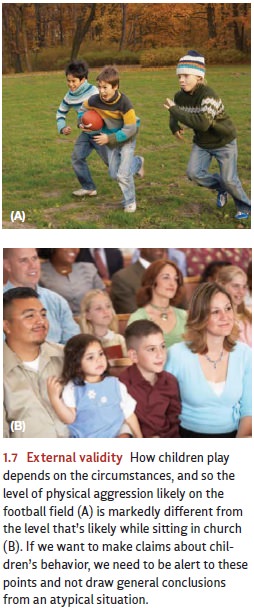Chapter: Psychology: Research Methods
Making Observations: Assessing External Validity
Assessing
External Validity
Clearly, then, different studies
rely on different sorts of data—sometimes a random sample, sometimes a maximum
variation sample, sometimes a single case. There is similar diversity in the situations that studies examine. In some
studies, we want the situation to be representative of the broader world; for
example, we hope our study of aggression on the playground will tell us about
aggression in other settings. In other studies, though, there’s no need for
representativeness because our hypothesis can be tested only by examining some
unusual or even artificial circumstance—one in which we can observe patterns
that would otherwise be hidden.
If we do want our study to
reflect the broader world, we need to ensure its externalvalidity—that is, to make sure the study does represent the
world as it exists outside ofour investigation. To ensure external validity, we
obviously need the sample of people in the study to be representative of the
broader population. We also need to make sure the circumstances of the study
accurately reflect those in the broader world. Imagine, for example, that while
studying aggression in children, we observe the children’s behavior when
they’re tired and cranky at the end of a long, hard school day. In this
setting, we might get a distorted picture of the children because in this
situation they’re quite likely to misbehave. As a result, we probably shouldn’t
draw conclusions from the study about how children behave in other
circumstances (Figure 1.7).

External validity also depends on
what’s being investigated. An investigator inter-ested in the human visual
system can probably study American college students and draw valid conclusions
about how vision works in all humans. This extrapolation from the data would be
valid simply because the properties of the visual system are rooted in the
biology of our species, so we can generalize widely from a relatively narrow
data set. But we’d have to be much more cautious in our generalizations if we
studied the same college students in hopes of learning about, say, human
romantic fantasies. In that case, our results might tell us little about anyone
other than the particular group studied.
Be aware, however, that questions
of external validity need to be resolved through research. For example, consider laboratory studies of memory. These studies
often involve college students memorizing either lists of words or brief
stories. Can we draw conclu-sions from these participants, and this task, about
how (for example) eyewitnesses will recall a crime or how medical patients will
remember a doctor’s instructions? To find out, we might need to study actual
eyewitnesses or patients and see if the principles derived from the laboratory
studies apply to these samples as well. This analysis would then help us
decide, in future studies, whether we could generalize from laboratory
findings.
Related Topics